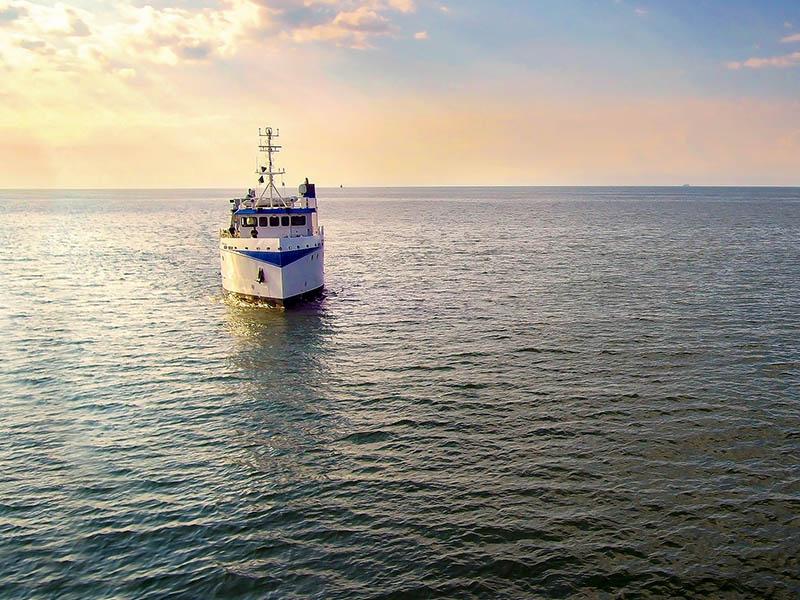Study Highlights the Benefits of Biodiversity for Commercial Fisheries

How is a commercial fishery like an investment portfolio? The more diverse, the better. According to a new study led by University of Virginia researchers, biodiversity in the Chesapeake Bay is the key to protecting the region’s watermen from boom-and-bust cycles by balancing out the natural rises and falls in fish populations.
The study, published in Ecological Applications, was led by UVA alumnus Sean Hardison, a former Ph.D. student and Virginia Sea Grant Fellow, in collaboration with his faculty mentor, Associate Professor Max Castorani of UVA’s Department of Environmental Sciences. Working with colleagues from William & Mary, the University of North Carolina at Chapel Hill, the University of Maryland and Canada’s Pacific Biological Station, the team analyzed 17 years of data to show how biodiversity stabilizes fisheries and protects watermen’s livelihoods.
The research team found that when different fish species peak at different times — a dynamic known as “asynchrony” — the overall fishery becomes more resilient. Much like a balanced portfolio cushions investors against market swings, biodiversity cushions watermen against economic volatility. However, the researchers also found that this result was impacted by the seasonal availability of harvested species, market demand and fishery management strategies.
“This work shows how commercial fisheries benefit from natural fluctuations in the ecosystem, but also how those benefits depend on human factors like market prices and management practices,” said Hardison, now a postdoctoral researcher at the University of Alaska Fairbanks.
To reach their conclusions, the researchers used data from the Chesapeake Bay Multispecies Monitoring and Assessment Program (CHesMMAP), which tracked juvenile-to-adult fish populations across the bay from 2002 to 2018. They paired those records with commercial landing values from the Virginia Marine Resources Commission and the Maryland Department of Natural Resources to understand how ecological patterns and policy decisions shaped economic outcomes.
Different states, different dynamics
In Maryland, commercial striped bass fishing is closed for part of the year to protect spawning stocks. Because striped bass dominate the commercial catch, that closure disrupted the natural asynchrony among species. Watermen shifted to other fish, which briefly made landings more stable, but revenues still fluctuated sharply because striped bass are far more valuable than other species.

In Virginia, where no seasonal closure exists, natural asynchrony initially helped stabilize harvests. But as the abundance of key species such as Atlantic croaker and spot declined between 2002 and 2018, landings became less balanced and more volatile.
Hardison’s former mentor and study coauthor Max Castorani, an associate professor in the Department of Environmental Sciences at UVA, said the findings illustrate how relying too heavily on a few high-value species such as striped bass can make a fishery portfolio unstable.
“Biodiversity doesn’t just make ecosystems healthier, it makes them steadier over time,” Castorani said. “It spreads risk and acts like insurance when certain fish are in short supply.”
Christopher Patrick, an associate professor and ecologist at the Batten School & VIMS, added, “The most stable system would be one where you’ve got a lot of different species and they’re all equally valuable. When you get an asymmetric value distribution, it kind of falls apart. This is what happens in Maryland to some extent.”
Patrick also emphasized the benefits of biodiversity to the fishing community. “When you’re thinking about protecting the watermen community and their industry, it’s not prudent to be thinking about stocks in isolation — you need to consider the whole portfolio of fish stocks.”
One practical avenue for diversification highlighted in the study is the continuing development of a commercial fishery for invasive blue catfish in the Chesapeake Bay. While prices have historically been modest, the research suggests that even small price increases could spur significant additional harvest and market participation.
Broader significance
The study emphasizes the importance of viewing fisheries through both ecological and economic lenses. While biodiversity naturally contributes to stability, factors such as regulations, markets and fishing practices can amplify, or weaken, that benefit.
While the study focused on the Chesapeake Bay, the nation’s largest and most economically important estuary, its findings can be applied broadly to fisheries around the world.
“Fisheries portfolios benefit from natural fluctuations in the ecosystem, but those benefits are mediated by management and human behavior” Hardison said. “Our research shows the ecological and economic benefits of biodiversity.”
We’re here to answer your questions! Contact us today.







